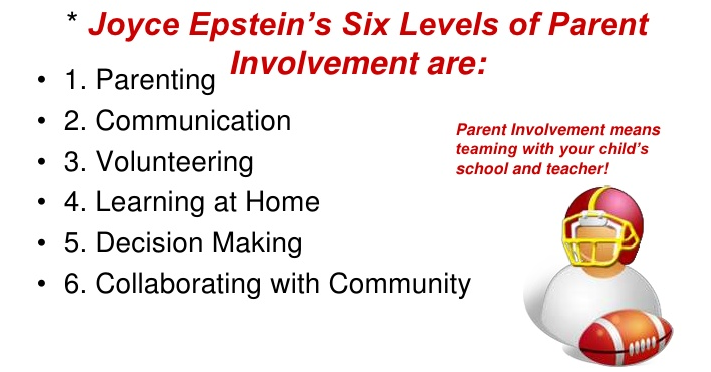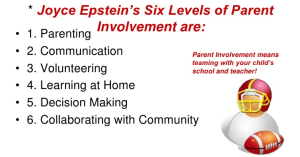Theories of Parental Involvement: Cultural Capital Theory and predicting Parental Involvement in Northwest Indiana Schools
Cultural Capital Theory
This paper by Ringenberg, McElwee and Isreal (2009) unveils yet another powerful theory that helps us understand how parental interactions may help or hinder student academic success: Cultural Capital Theory. According to Bourdieu’s theory of cultural reproduction, children from middle-class families are advantaged in the academic field due to their possession of cultural capital. Cultural Capital refers to “non-financial assets that promote social mobility beyond economic means.” In an educational context (see Lee and Bowen), CCT predicts that parents with greater cultural capital will be more involved, and this involvement will increase student engagement and achievement motivation.
Epstein’s Six Levels of Parental Involvement
Ringenberg, McElwee and Isreal (2009) draw on Epstein’s Six Levels of Parental Involvement, which assists educators in developing school and family partnership programs. Applying this framework to Northwest Indiana Schools led to the conclusion that CCT partly explains children’s success at school. This is in line with Sullivan’s (2001) finding, that CCT has some effect on national exam grades. Overall, Parenting, one of the Six Types of Parental Involvement, was the strongest predictor of positive academic outcomes, including “activities such as explaining confusing ideas, having children’s books in the home, ensuring children attend regularly, and reading regularly.”
Here is a breakdown of Joyce Epstein’s framework which defines six different types of Parent Involvement, taken from the National Network of Partnership Schools (US):
Parenting – Assist families with parenting and child-rearing skills, understanding child and adolescent development, and setting home conditions that support children as students at each age and grade level. Assist schools in understanding families.
Communicating – Communicate with families about school programs and student progress through effective school-to-home and home-to-school communications.
Volunteering – Improve recruitment, training, work, and schedules to involve families as volunteers and audiences at the school or in other locations to support students and school programs.
Learning At Home – Involve families with their children in learning activities at home, including homework and other curriculum-linked activities and decisions.
Decision-Making – Include families as participants in school decisions, governance, and advocacy through PTA/PTO, school councils, committees, and other parent organisations.
Collaborating with the Community – Coordinate resources and services for families, students, and the school with businesses, agencies, and other groups, and provide services to the community.
Implications and Applications
The study describes four implications, which I read as advice, that I will bear in mind while I design an intervention to facilitate parental involvement for my SLA project:
1. “When designing programs to increase parental involvement, or some aspect of it, it is practical to bear in mind which parents tend to be less involved and develop strategies to connect with them” (p115). I need to think about, not just what the learning object will be, but how I will introduce my idea to the parents. I must find a way not to seem as if I am pointing the finger or that I am highlighting a ‘lack of parental involvement.’
2. “Lack of time was a strong predictor of nearly all areas of parental involvement…if there are ways parents can participate in time-limited ways, then promoting those may draw more ‘time-limited parents’ into the parental involvement process” (p116). Recently I have begun to think about the possibility of integrating technology into the design of my intervention. In this way, I certainly hope not to waste, and maybe even save, parents time.
3. “Knowing that Learning in the Home, at least in it’s current configuration, tends to steadily decrease as children progress in grade, will allow researchers or program planners to recognise an effective intervention when they may otherwise have missed it” (p116). As I am designing an intervention that brings parents, teachers and students closer together, perhaps I should be more age-conscious. Perhaps I should be aware that as students get older, the desire to be with their parents decreases.
4. “It would be valuable to explore which teacher or principal behaviours result in greater comfort for parents.” An intervention that allows exploration of impressions or perceptions of teachers and the school would be beneficial. But would parents here in China buy into a platform that encourages an open-dialogue? To be continued…


